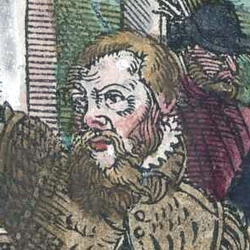|
|
You are not currently logged in. Are you accessing the unsecure (http) portal? Click here to switch to the secure portal. |
Wiktenauer:Main page/Featured
| Joachim Meÿer | |
|---|---|
 | |
| Born | ca. 1537 Basel, Germany |
| Died | 24 February 1571 (aged 34) Schwerin, Germany |
| Spouse(s) | Appolonia Ruhlman |
| Occupation |
|
| Citizenship | Strasbourg |
| Patron |
Heinrich von Eberst
|
| Movement | Freifechter |
| Influences | |
| Influenced | |
| Genres | Fencing manual |
| Language | Early New High German |
| Notable work(s) | Gründtliche Beschreibung der Kunst des Fechtens (1570) |
| Manuscript(s) |
|
| First printed english edition |
Forgeng, 2006 |
| Concordance by | Michael Chidester |
| Signature | |
Joachim Meÿer (ca. 1537 - 1571) was a 16th century German Freifechter and fencing master. He was the last great figure in the tradition of the German grand master Johannes Liechtenauer, and in the last years of his life he devised at least three distinct and quite extensive fencing manuals. Meÿer's writings incorporate both the traditional Germanic technical syllabus and contemporary systems that he encountered in his travels, including the Italian school of side sword fencing. In addition to his fencing practice, Meÿer was a Burgher and a master cutler.
Meÿer was born in Basel, where he presumably apprenticed as a cutler. He writes in his books that he traveled widely in his youth, most likely a reference to the traditional Walz that journeyman craftsmen were required to take before being eligible for mastery and membership in a guild. Journeymen were often sent to stand watch and participate in town and city militias (a responsibility that would have been amplified for the warlike cutlers' guild), and Meÿer learned a great deal about foreign fencing systems during his travels. It's been speculated by some fencing historians that he trained specifically in the Bolognese school of fencing, but this doesn't stand up to closer analysis.
Records show that by 4 June 1560 he had settled in Strasbourg, where he married Appolonia Ruhlman (Ruelman) and joined the Cutler's Guild. His interests had already moved beyond knife-smithing, however, and in 1561, Meÿer petitioned the City Council of Strasbourg for the right to hold a Fechtschule (fencing competition). He would repeat this in 1563, 1566, 1567 and 1568; the 1568 petition is the external record in which he identifies himself as a fencing master.
Meÿer wrote his first manuscript (MS A.4º.2) in either 1560 or 1568 for Otto Count von Sulms, Minzenberg, and Sonnenwaldt. Its contents seem to be a series of lessons on training with longsword, dussack, and side sword (rapier). His second manuscript (MS Var.82), written between 1563 and 1570 for Heinrich Graf von Eberst, is of a decidedly different nature. Like many fencing manuscripts from the previous century, it is an anthology of treatises by a number of prominent German masters including Sigmund Schining ein Ringeck, pseudo-Peter von Danzig, and Martin Syber, and also includes a brief outline by Meyer himself on a system of side sword fencing based on German Messer teachings. Finally, on 24 February 1570 Meÿer completed (and soon thereafter published) an enormous multiweapon treatise entitled Gründtliche Beschreibung der Kunst des Fechtens ("A Thorough Description of the Art of Combat"); it was dedicated to Johann Casimir, Count Palatine of the Rhine, and illustrated at the workshop of Tobias Stimmer.
Unfortunately, Meÿer's writing and publication efforts incurred significant debts (about 1300 crowns), which Meÿer pledged to repay by Christmas of 1571. Late in 1570, Meÿer accepted the position of Fechtmeister to Duke Johann Albrecht of Mecklenburg at his court in Schwerin. There Meÿer hoped to sell his book for a better price than was offered locally (30 florins). Meÿer sent his books ahead to Schwerin, and left from Strasbourg on 4 January 1571 after receiving his pay. He traveled the 500 miles to Schwerin in the middle of a harsh winter, arriving at the court on 10 February 1571. Two weeks later, on 24 February, Joachim Meÿer died. The cause of his death is unknown, possibly disease or pneumonia.
Antoni Rulman, Appolonia’s brother, became her legal guardian after Joachim’s death. On 15 May 1571, he had a letter written by the secretary of the Strasbourg city chamber and sent to the Duke of Mecklenburg stating that Antoni was now the widow Meÿer’s guardian; it politely reminded the Duke who Joachim Meÿer was, Meÿer’s publishing efforts and considerable debt, requested that the Duke send Meÿer’s personal affects and his books to Appolonia, and attempted to sell some (if not all) of the books to the Duke.
Appolonia remarried in April 1572 to another cutler named Hans Kuele, bestowing upon him the status of Burgher and Meÿer's substantial debts. Joachim Meÿer and Hans Kuele are both mentioned in the minutes of Cutlers' Guild archives; Kuele may have made an impression if we can judge that fact by the number of times he is mentioned. It is believed that Appolonia and either her husband or her brother were involved with the second printing of his book in 1600. According to other sources, it was reprinted yet again in 1610 and in 1660.
The Fechtschule of Joachim Meÿer in Strasbourg, a thriving school of fence equal to many others in Germany at the time, was taken over during the Acquisition of Strasbourg by Louis XIV in 1681; it was turned into the "Academie de Arms" and essentially absorbed into the French school of fence.
(Read more...)
